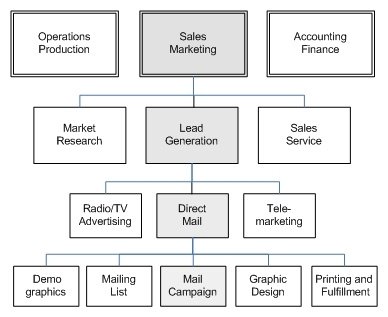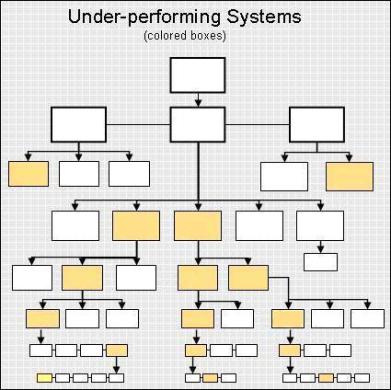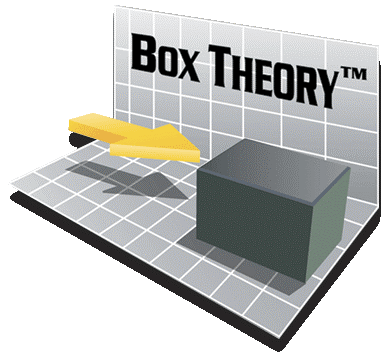It is commonly understood that to tackle and complete a big project, one should break the task down to smaller, more manageable subtasks. How do you eat an elephant? “One bite at a time.” It’s the same idea. This true principle makes a lot of sense and is one of the underlying premises of Box Theory™ methodology and software (The Box Theory Way™).
So, what exactly is Box Theory™, you may ask.
Box Theory™: Four Supporting Concepts
Box Theory™ is a statement of theory that applies to all business-building activities. Before presenting it, however, you must first understand the four supporting concepts:
- A business is made up of many systems and processes.
- Each process consists of larger activities, smaller tasks, and even smaller steps within each task.
- Every activity, task, and step can be represented by a BOX on a flowchart.
- Every “BOX” is of greater or lesser importance to organizational strategies and goals, and currently produces results that are either acceptable or unacceptable.
Let me briefly explain each of these four supporting statements:
One – A business is made up of many systems and processes. Your organization has numerous systems and subsystems that enable you to deliver products and services. They may be rudimentary, undocumented, or ineffective, but they are currently the way you do things. The following table lists a few typical business systems.
|
EXAMPLES OF BUSINESS SYSTEMS/BOXES
|
||
|
Lead Generation
|
Hiring
|
Order Fulfillment
|
| Lead Conversion |
Training
|
Purchasing
|
| Website |
Customer Care
|
Inventory Management
|
| Accounting | Quality Control |
Shipping/Receiving
|
|
Payroll
|
Information Systems | Custodial |
|
Collections
|
Estimating/Pricing |
Others unique to your company
|
Two – Each process consists of larger activities, smaller tasks, and even smaller steps within each task. Marketing, for example, is a high-level business activity or system. Within marketing, you will likely have a system for generating sales leads. Within the lead-generation system, you may have tasks or subsystems such as telemarketing, direct mail, and radio advertising. Within direct mail, there are steps (a procedure or checklist) to carry out this task.
If you could create a framework of systems for your entire business—marketing, operations, finance, human resource, and so forth—and show it on a drive-in movie screen (remember those?), you would see every activity, task, and step cascade down to levels of minute detail. (Don’t worry, you won’t be doing this.)

Three – Every activity, task, and step can be represented by a BOX on a flowchart. A flowchart visually represents the individual steps within a system. With labeled flowchart BOXES and arrows, you can quickly see how the process moves from the beginning to the end. For example, consider a simple version of an order processing system where you 1) Receive the order, 2) Pack the order, 3) Label the box, 4) Place the box for pick-up. It might look like the flowchart below. (With enough time and money, you could flowchart your entire business, but you’re not going to do that either.)

Four – Every flowchart “BOX” is of greater or lesser importance to organizational strategies and goals, and currently produces results that are either acceptable or unacceptable. Here’s where we thank our good friend Pareto (80-20 Rule). Only about 20% of the flowchart BOXES have much influence on your overall business success. As a result, you will focus your attention on the important or under-performing boxes that make a difference to your customers and profitability.
If your BOX called Direct Mail—under the Lead Generation box—is not helping you achieve your sales goals, improvement is necessary. On the other hand, if your Custodial BOX is a little weak, you might not worry about it right now; it won’t put you out of business. The following organization chart is an aerial view of business systems and processes. The colored BOXES are the ones deserving of your attention. (The limiting constraints are on the bottom row.)

Each BOX is a building block of your business. Each has a specific purpose and is interdependent with other BOXES. Each BOX is itself a process with components and contributes to the greater whole. A few BOXES are critically important, while others are not. By altering or improving any BOX (the cause), you can change or improve the outcome of the entire system (the effect).
Box Theory™, the Theory
Having laid this foundation of supporting statements, Box Theory™ is simply this:

If you can determine the vital few “BOXES” that cause your key business outcomes, and elevate them to higher performance levels, the effect will be greater customer loyalty, profitability, growth, and overall business success.
Consider this practical example:
Let’s say that your unique organization chart has three major functions—marketing, operations, and administration. Under the BOX called Administration are BOXES labeled Finance, Human Resource, Office Management, and Facilities.
If you drill down on Facilities, there may be business functions or BOXES labeled Security, Furniture and Equipment, Computer Support, and Custodial. Within Custodial, for example, there are more detailed steps or BOXES such as Vacuum Floor, Dust Furniture, Empty Trash, Clean Bathroom, and so forth.
If you want even more control of the Clean-Bathroom BOX, lower-level tasks might include Clean the Mirror, Mop the Floor, Scrub the Sink and Sanitize the Toilet. At the lowest level of detail, you may even have a list of steps for cleaning each item—something a professional cleaning company might define for its employees. Each task can be represented by a BOX.
You may not go this deep on your custodial system, but you will go deep on a few of your core systems that touch customers. And don’t worry at this point about tracking and connecting all the BOXES. My purpose, for now, is that you see the model—the big picture—how everything fits together like the pieces to a puzzle.
In a workshop I gave, a person came to me during the break and said that there was no toilet paper in the restroom. You can bet that toilet paper was an important detail for that person. As in all systems, the solution is the same—drill down until you find the BOX that is causing the problem, and then fix it. We changed our cleaning checklist to include putting an extra roll of paper on the back of the toilet. We never had that problem again. Thank goodness!
Important details are everywhere in your business. You can only manage them with good systems and processes, your workhorses for getting the job done right day-in and day-out.
High Performance Attributes
Box Theory™ is simple, yet profound in its application. However, breaking a business down to individual BOXES, like the pieces to a puzzle, is not the whole story. Knowing how to elevate the BOXES to higher performance levels is where the real power lies.
I have previously referred to high-performance systems. But what does that mean? Usually, it is just language to impress and make things sound super-duper. However, the Box Theory™ method defines high-performance in a very specific way. You can know exactly what qualifies a BOX or system to be high-performance. Let me explain.
Every BOX or system you choose to improve is made up of a procedure and components—nothing else. However, there are ways to elevate the process and turbo-charge its performance. From a study of the major improvement methods (six sigma, lean thinking, and the Theory of Constraints), my own experience, and some inspiration for which I am grateful, I have identified 7 “High-Performance Attributes” that can be associated with a BOX or system.
Each attribute is a quality that improves the output of the BOX. You can elevate the performance of any BOX by taking steps to increase the number of its High-Performance Attributes.
Below are listed the 7 High-Performance Attributes and their description. You may not completely understand each description now, but they will become clear later on. They are easy to understand and based upon the tried and proven principles.
A high-performance BOX is one that earns all applicable attributes; some attributes may not apply to a given BOX. The 7 possible attributes are as follows:
Table of High-Performance Attributes
| ATTRIBUTE | DESCRIPTION | |
| 1 |
Ownership |
When an owner is assigned to a box, there is accountability for the performance of that process. |
| 2 |
Balanced Scorecard Driver |
The BOX (system or process) is a “driver” if it directly contributes to the achievement of a company goal (e.g., when the lead generation system/BOX is improved, sales goals are reached.) |
| 3 |
Components |
A system is fully operational if it contains the people, documents, tools, and resources required to perform the task at the optimum level (a major weakness of many businesses). |
| 4 |
Value-Added |
The BOX is “value-added” if the task ultimately benefits customers and is something they would be willing to pay for. Value-added tasks in a process create a “value stream.” Tasks that do not add value to the customer are waste (e.g., handling inventory or fixing problems are not value-added). |
| 5 |
High-Yield |
A task that has a 99% yield, or one mistake/error/defect in 160 opportunities, is a 4 Sigma or high-yield process (quality processes lower costs and please customers). |
| 6 |
Fast |
A BOX or process is considered “fast” when it has maximized throughput, that is, minimum lead time, maximum completion rate, minimized “speed bumps” (e.g., clutter, poor layout, stop-start workflow, etc.) and optimized pacing (sales and on-hand inventory are synchronized). |
| 7 |
Non-Constraint |
A BOX (step) that is not a bottleneck in a system or process is a non-constraint. A bottleneck is any BOX whose capacity is equal to or less than the demand placed upon it (too many inputs). A non-bottleneck is any BOX whose capacity is greater than the demand placed upon it. |
The Simple Steps of Box Theory™
We have now covered the basics of Box Theory™. However, I want to emphasize that it is quite a simple process; many students have learned to do it well.
To summarize, let me give you a quick overview:
A business consists of a collection of systems or “BOXES.” About 20% of the BOXES have the most influence on your business results. You will start by developing or improving the systems that have the biggest payoff—those that are essential to your success or those that are obstacles to your success. The basic process for developing a business system (BOX) requires six steps:
- Select a priority system/Box that you want to create or improve.
- State the problem and/or the desired objective of the system Box.
- Write down the procedure or steps in the system. (I like to create a flowchart on a whiteboard with the help of the people who operate the system.) Work the process until you think it is the best way of getting the result you are after.
- Identify and acquire all the component parts to make the system operational (e.g., forms, checklists, materials, equipment).
- Elevate system-performance over time by applying the 7 High-Performance Attributes.
- Measure system results. Use performance data and worker feedback to make further improvements until desired results are achieved.
